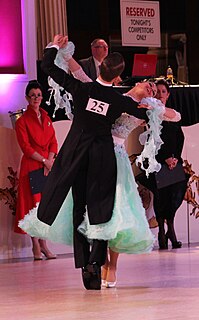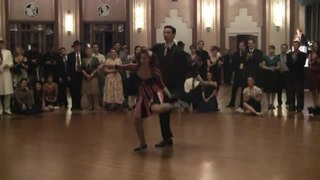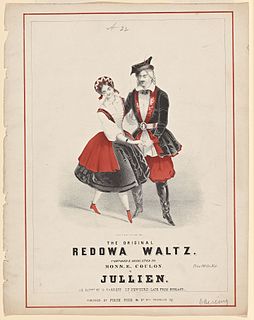Related Research Articles

Ballroom dance is a set of partner dances, which are enjoyed both socially and competitively around the world, mostly because of its performance and entertainment aspects. Ballroom dancing is also widely enjoyed on stage, film, and television.

The Charleston is a dance named after the harbor city of Charleston, South Carolina. The rhythm was popularized in mainstream dance music in the United States by a 1923 tune called "The Charleston" by composer/pianist James P. Johnson, which originated in the Broadway show Runnin' Wild and became one of the most popular hits of the decade. Runnin' Wild ran from October 28, 1923, through June 28, 1924. The peak year for the Charleston as a dance by the public was mid-1926 to 1927.
An Aerial is a dance move in Lindy Hop or Boogie Woogie where one's feet leave the floor. As opposed to a lift, aerial is a step where a partner needs to be thrown into the air and then landed in time with the music. Each aerial consists of a preparation ('prep'), jump or trick itself and the landing.

Swing dance is a group of social dances that developed with the swing style of jazz music in the 1920s–1940s, with the origins of each dance predating the popular "swing era". Hundreds of styles of swing dancing were developed; those that have survived beyond that era include Lindy Hop, Balboa, Collegiate Shag, and Charleston. Today, the best-known of these dances is the Lindy Hop, which originated in Harlem in the early 1930s. While the majority of swing dances began in African American communities as vernacular African American dances, some influenced swing-era dances, like Balboa, developed outside of these communities.

A redowa is a dance of Czech origin with turning, leaping waltz steps that was most popular in Victorian era European ballrooms.
The schottische is a partnered country dance that apparently originated in Bohemia. It was popular in Victorian era ballrooms as a part of the Bohemian folk-dance craze and left its traces in folk music of countries such as Argentina, Finland ("jenkka"), France, Italy, Norway ("reinlender"), Portugal and Brazil, Spain (chotis), Sweden, Denmark ("schottis"), Mexico, and the United States, among other nations. The schottische is considered by The Oxford Companion to Music to be a kind of slower polka, with continental-European origin.
This is a list of dance terms that are not names of dances or types of dances. See List of dances and List of dance style categories for those.
Because ballet became formalized in France, a significant part of ballet terminology is in the French language.
The Big Apple is both a partner dance and a circle dance that originated in the Afro-American community of the United States in the beginning of the 20th century.
Cajun Jig or Cajun One Step is among the simplest of Cajun dance forms. It has only one basic step. The Cajun Jig was popular in Louisiana in the late 1980s and early 1990s, but remains a mainstay of dancers. Often, this step pattern is alternated with other styles, during a single song, particularly among those who are regular dancers, in urban and non-traditional settings, or those who are also Zydeco dancers.
The hustle is a catch-all name for some disco dances which were extremely popular in the 1970s. Today it mostly refers to the unique partner dance done in ballrooms and nightclubs to disco music. It has some features in common with mambo, salsa and swing dance. Its basic steps are somewhat similar to the discofox, which emerged at about the same time and is more familiar in various European countries. In the 1970s there was also a line dance called the hustle. Modern partner hustle is sometimes referred to as New York hustle, however, its original name is the Latin hustle. People still do this dance around the world today.
The different slow motion solo form training sequences of T'ai Chi Ch'uan are the best known manifestation of T'ai Chi for the general public. In English, they are usually called the hand form or just the form; in Mandarin it is usually called ch'uan: 拳. They are performed slowly by beginners and are said to promote concentration, condition the body and acquaint students with the inventory of motion techniques for more advanced styles of martial arts training. There are also solo weapons forms, as well as much shorter and repetitive sequences to train power generation leverages as a form of ch'i kung. The various forms of Wu-style pushing hands have their own one person drill routines, as well, which fulfil some of the same functions as the power generation drills.

The cha-cha-cha, is a dance of Cuban origin. It is danced to the music of the same name introduced by the Cuban composer and violinist Enrique Jorrin in the early 1950s. This rhythm was developed from the danzón-mambo. The name of the dance is an onomatopoeia derived from the shuffling sound of the dancers' feet when they dance two consecutive quick steps that characterize the dance.
The Tranky Doo is a jazz dance choreography.

Acrobatic rock'n'roll is a very athletic, competitive form of partner dance that originated from lindy hop. Unlike lindy hop, however, it is a choreographed dance designed for performance. It is danced by both couples and groups, either all-female or four to eight couples together. This is normally a very fast and physically demanding dance.
Locking is a style of funk dance, which is today also associated with hip hop. The name is based on the concept of locking movements, which means freezing from a fast movement and "locking" in a certain position, holding that position for a short while and then continuing at the same speed as before. It relies on fast and distinct arm and hand movements combined with more relaxed hips and legs. The movements are generally large and exaggerated, and often very rhythmic and tightly synced with the music. Locking is performance oriented, often interacting with the audience by smiling or giving them a high five, and some moves are quite comical.

Assyrian folk dances are sets of dances that are performed throughout the world by Assyrians, mostly on occasions such as weddings, community parties and other jubilant events.
The Nutbush is a line dance performed to Tina Turner's song "Nutbush City Limits".
References
- ↑ "Ryan Francois and Jenny Thomas". ryanandjenny.com. 2007. Retrieved 2007-07-23.